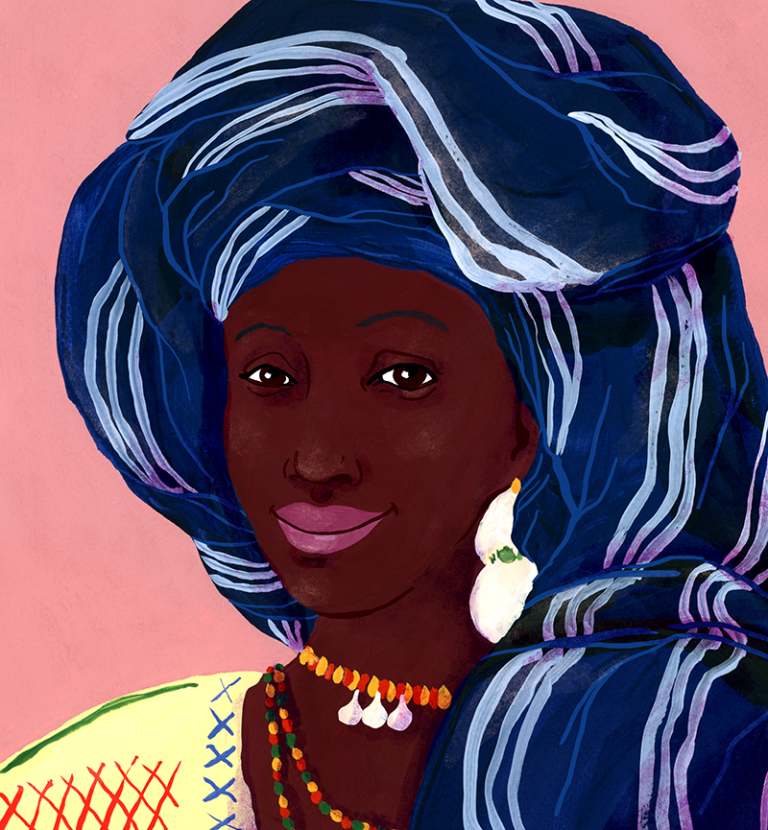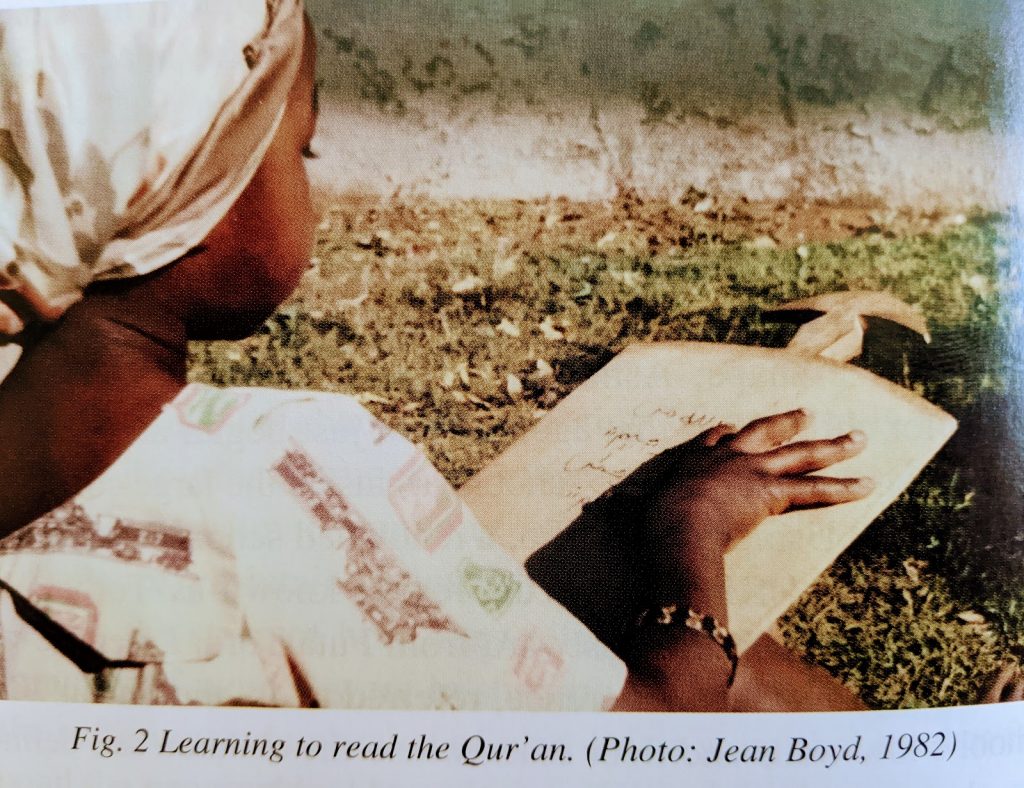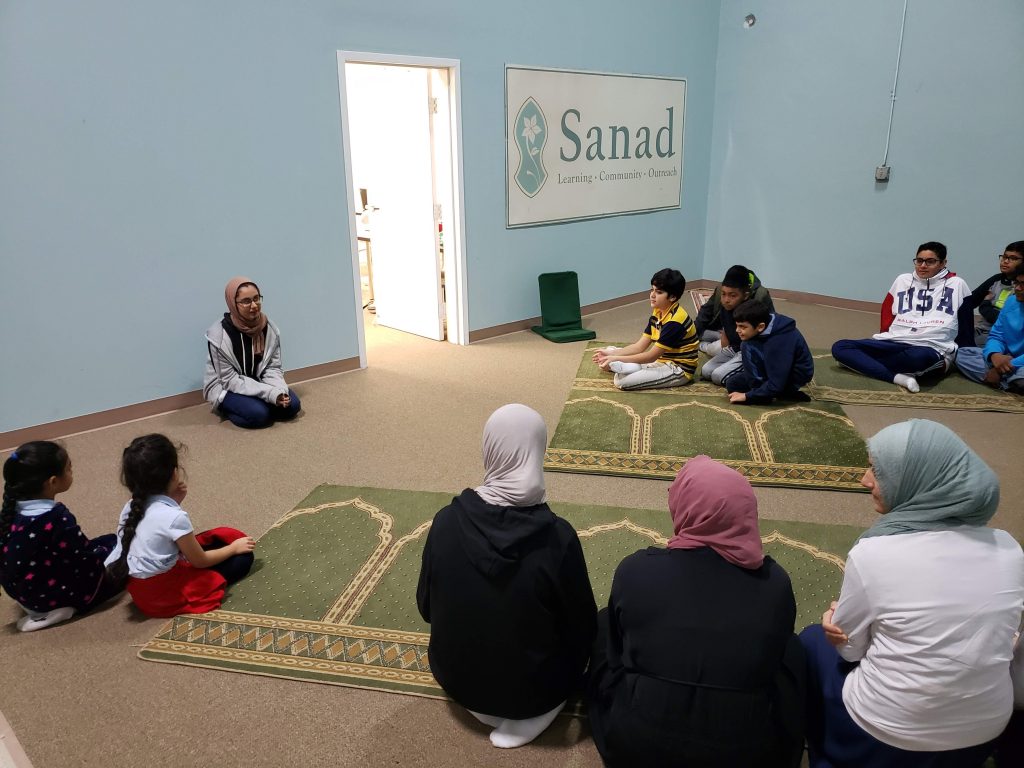The Life & Legacy of Nana Asma’u: 1793- 1864

Almost two years ago in the Spring of 2019, a friend of mine whose first name is my surname Syeda joined me to attend a Rabata Retreat in Tampa, Florida. We drove from Miami early in the morning and made the three hour road trip landing directly at the program that was being hosted at a University Campus. It was my first time attending a Rabata program. We attended just for the day and I made a side trip to visit a classmate whom I was taking a course with at the Harvard Extension School in nonprofit management. It was a short, peaceful and memorable trip. During the day retreat, Anse Tamara Gray introduced a project Rabata had been working on for a few years documenting the lives of Muslim Female Scholars. What stood out about the project were the beautifully produced hand drawn portraits of these women. The sketches pranced out with beautiful vibrant colors capturing the women’s inward and outward beauty somehow, a few in their youth while others in their mature age. The common theme of each masterpiece was the semblance of strikingly simple, ordinary and relatable faces. You could imagine yourself as one of them by simply gazing at the portrait. My mind faded on many of the beautiful women that were discussed except Nana Asma’u. Her portrait, her name and her aura took hold in my heart. It was not the first time I had heard her name but it was the first time I felt connected to her and had a strong impulse to learn more about her life. Just a few days after my return home, I was listening to a series of lectures by Shayk Abdul Hakim Murad on Leaders in Islamic history, and he began highlighting the life of Nana Asma’u. I smiled and listened to the 2 hour lecture in a single sitting. I was captivated. I continued my research on her and read every article and piece of information I could find on her. I ordered a biography on her life by Boyd & Mack2, a rare compilation that attempts to capture an accurate account of her life and contributions. Her biography inspired me so much that I made a silent wish in my heart to be given the permission to visit the library of Timbuktu one day and hold an original book of Nana Asma’u in my hands.
A Life of Tradition, Education & Impeccable Character

(*See endnote 2 for complete reference)
Nana Asma’u was born at the turn of the century around 1793 in Degel, West Africa. She began attending school at age 5 that was situated in the large compound built by her father Usman dan Fodio. Usman dan Fodio was a renowned scholar and the head of the Fulanis community in the region known as Toronkawa. Asma’u was a sibling among 9 others in the Fodio household but her father took an intimate and keen interest in the education of each one of his children. In fact, Asma’u and her sister Hadija both would go on to memorize the Qur’an while excelling in other religious and practical sciences. Usman Dan Fodio, also referred lovingly as “the Shehu” by his community was dedicated to his faith and a commitment to preserve the sunnah of the Prophet Muhammad peace be upon him through striving for a just, equitable and socially vibrant community. This passion had a deep and profound influence on his children. Asma’u was shaped by her father’s qualities of sincerity, humility, forbearance and an unwavering conviction in sharing and teaching the sunnah of Prophet peace be upon him. It was not uncommon for Asma’u to hear stories from her father about his meetings with Hausa farmers, the wealthy residents, as well as the rulers and officials of local courts. The Shehu believed in progress of his people through education, especially of womenfolk and established schools and places of higher learning to bring his vision to fruition. Asma’u would not only carry her father’s legacy but would create a unique and unprecedented one for herself. Her formative years in mentorship and training by her father, her teachers of religious and worldly sciences and her astute intelligence would guide her into becoming an impeccable leader and influencer in her time and beyond.
A Visionary: Principled & Practical Leadership

Nana Asma’u had a keen eye for observing and understanding the state and condition of the people in her community. She witnessed many challenges that troubled the lives of common folks like cheating and corruption in trade and selling, bribery, bending of rules for the rich and elite, limiting opportunities of education for women, evasion of alms- tax by the wealthy, abuses and mistrust of inheritance laws and property just to name a few. She believed that if women could be educated on ideas of morality, ethics and justice as well trained to contribute with their intellect and skills as productive and equally contributing members of the community, the society as a whole had a far better chance of ridding itself of these moral and material ailments.
Asma’u was fluent in many languages including Aarbic, Hausa, Fulani and other dialects which allowed her to communicate with people from every walk of life. She was brilliant yet affable and remained close to the people and their daily struggles. She was strategic and deliberate but came up with simple solutions to guide the movement of women in her community towards progress. A prominent form of her influence became poetry, promulgating her message in a quick and effective way especially amongst the common people. Many of her poems shared eyewitnesses and accounts of her father’s struggles for the Hausa people with a calling to live by higher morals of justice, peace and excellence.
Her marriage to a prominent student of the Shehu, named Gidado who was a scholar in his own right would only strengthen her mission and her ability to continue her service. In her role as the wife of Gidado, Asma’u would take lead responsibility in managing, coordinating and overseeing the affairs of the womenfolk in her household and of other women in the community. Many of her original poems and translated texts empowered the Hausa women to take control of their condition and work towards its betterment. Although a remarkable writer, Asma’u did not limit her influence through the pen and paper alone. She would visit the women in the community daily, listen to their concerns, help resolve conflict, encourage observance of ethical and moral standards, reinforce the value of education, while condemning cheating, falsehood, gossip, slander and any other forms of behaviour that may lead to moral degradation. Asma’u developed a network for women to ensure control and governance over their lives, decisions related to their children, economics and other social welfare issues. The network would take the form of a sophisticated organization named Yan Taru, with a mission to promote progress, justice and peace through social reform, scholarship and teaching of the Hausa women.
Nana Asma’u also played a critical role as a political and military advisor to her brother Muhammad Bello after the passing of their father the Shehu. She had earned a reputation even amongst the men for her sagacious perspective on political and social matters. She was a natural diplomat yet uncompromising towards her principles and values. As political unrest grew in the region, the Hausa community would be forced to migrate and fight against the colonial rule and aggression, threatening their culture, heritage, and the very connection and commitment to their faith. Their great legacy based on education and knowledge of religious and other highly revered sciences will hang in the balance, in fact almost destroyed by the onset of colonialism. Her demise from this world would follow the slow plundering of her community, especially the women despite their best efforts to preserve her legacy through education of women.
Reconnecting the Severed Tie
I have gravitated to different people at different points and times in my life but I know my gravitation and inclination was shaped and influenced by the principles and values my parents disseminated in me. My path constantly crossing with the memory of Nana Asma’u did not feel like a coincidence to me. At one point, it felt like everywhere I looked and turned, I found her name emerging again and again in my life. I spoke to both my children about this strange occurrence and even bought a children’s book to share highlights about her life with them. To me, finding good role models for our children means having good ones ourselves first. A part of the journey for me has been understanding the how and why this connection to our heritage, history and faith has weakened over time. It continues to shape my curiosity in Muslim historical and contemporary figures and why this connection for us and our children must be preserved.
The entire month of February is dedicated to commemoration of Black and African Americans in America; serving as an apt reminder that we can use current traditions to strengthen our understanding of the past. We at Sanad Trust Foundation believe in connecting to this legacy for the children and families we serve. Shedding light on these important figures and their legacies is one way we can honor them, remain connected to them and hope that our children’s path crosses with some of them in the future, as it has for some of us. Another way and perhaps even more important is to continue their legacy by following in their footsteps and taking inspiration from their lives to build our own. My friend and colleague, Ameena Nasir, reminded me what made the Yan Taru movement initiated by Nana Asma’u so successful. By studying and closely examining the characteristic and qualities of the organization, it becomes evident that Nana Asma’u grounded the organization by committing to the following principles, amongst many others:
- A sincere intention and concern for the preservation of fitra (the good nature inherent in all human beings),
- Dissemination of knowledge that connects one to their faith, culture, heritage and other worldly sciences
- Preservation of a healthy, positive and principled environment
Nana Asmau’s approach and establishment of an effective model for teaching and learning focused on two things; Educating and training older women in the community and pairing them up with young girls to receive the same training. The two key areas Nana Asma’u seemed to have focused on was
- providing the knowledge and resources that inspire and motivate the mind and heart
- Establishing a system based on relationship between Mentor/Coach and Students
We at Sanad Trust Foundation are striving to live by similar principles and guidelines. As one of our taglines states: Have Adab. Share Knowledge. Show Love. We invite you to join this mission or discover ways you or your family may benefit from our services by browsing our website. Remember to subscribe to our newsletter to stay connected, follow us on Instagram @sanadtrust, Facebook (sanadtrust) and subscribe to our YouTube Channel.

Endnotes:
- DOUNIA BENDOUMA, (March 16, 2019), “Nana Asma’u: The forgotten Nigerian Scholar”, Retrieved from https://litteraturesarrazinecom.home.blog/2019/03/16/nana-asmau-1793-1864-la-savante-et-feministe-nigerienne-du-xixe-siecle-oubliee/
- See Boyd. J & Mack B, (2013), “Educating Muslim Women: The west African Legacy of Nana Asma’u”, Interface & Kube Publishing, UK.
- See Original image and poster of Nana Asma’u at https://www.rabata.org/leadership-and-legacy/nana-asmau/
This is a test bio for the widget style
